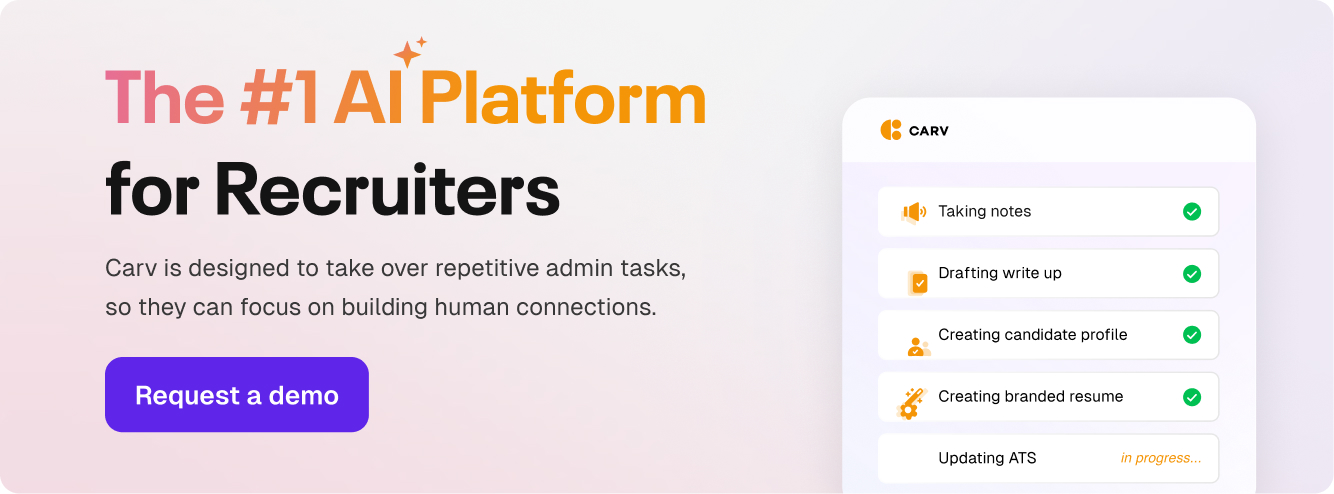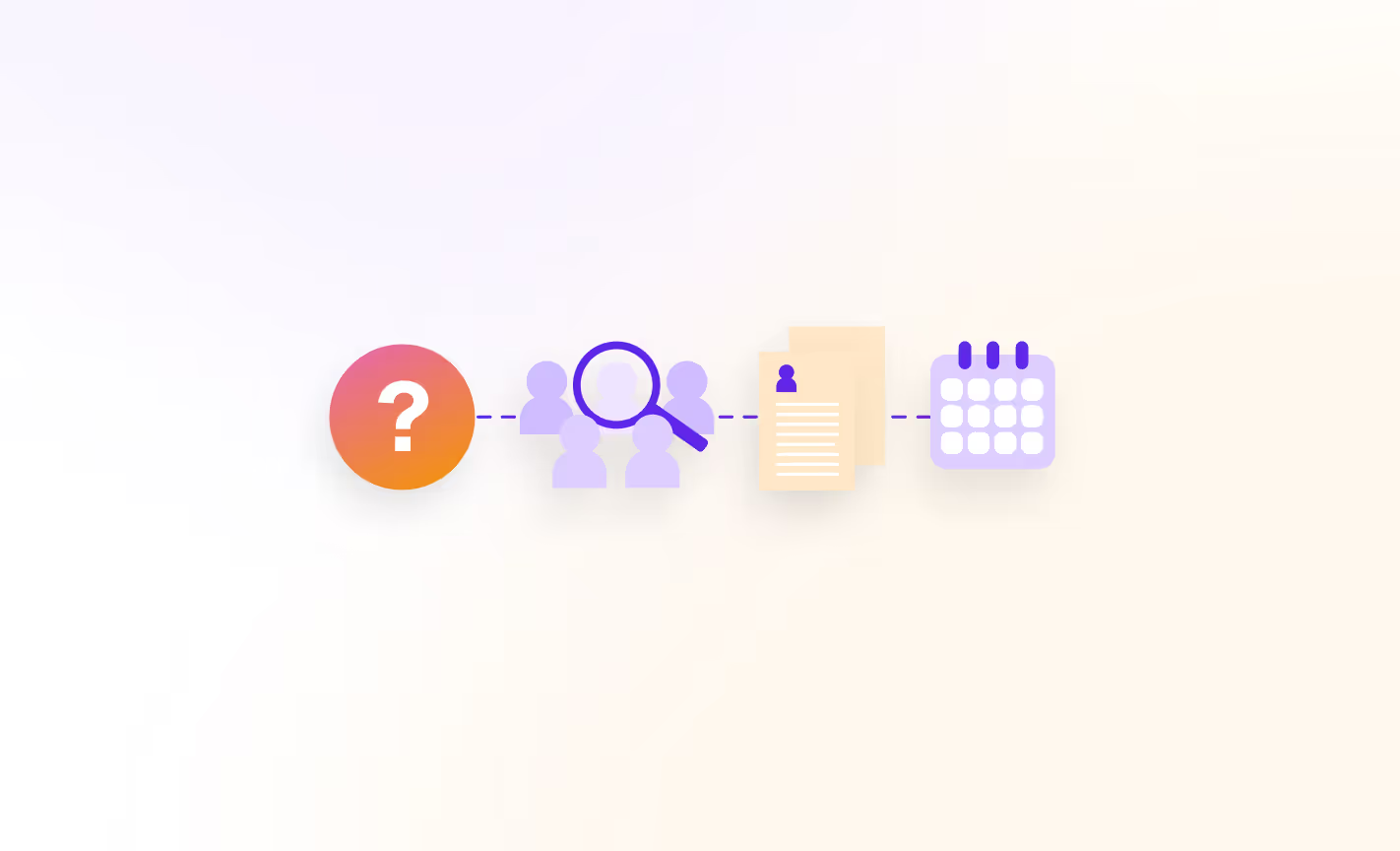The recruitment process feels stuck in a rut. Despite constant tweaks and changes, the same issues plague it year after year.
Conversational chatbots and automation promised a revolution, but they've fallen short.
We're still facing slow processes resulting in prolonged hiring times, a disjointed candidate experience, and recruiters burdened with time-consuming admin tasks.
Which begs the question: are we focusing on the wrong things?
Maybe it's time to rethink how we recruit, and make room for a new approach - one that doesn’t revolve around the process but emphasizes effectiveness and a positive experience for everyone involved.
Traditional automation might fall short, but AI technology has the potential to make a significant impact, especially on the bottom line.
The efficiency paradox: How speed slows down recruitment
The relentless pursuit of a faster recruitment process has become a double-edged sword.
In our race to shorten the time-to-fill, we've sacrificed quality for speed, resorting to superficial resume screening and relying heavily on keyword-based candidate sourcing and templated outreach sequences.
While automation algorithms can speed up the hiring process, the tools we use today often miss out on qualified candidates with unconventional resumes, because they don't fit the standard format recruiting software can “understand”.
This leads to quality candidates not hearing back from recruiters, prompting them to flood job postings with applications in the hope that one will stick.
In response, recruitment teams, pressured by the need to fill seats faster, push more candidates through to the next stages in hopes of finding a good fit that won't flake out.
But the time to hire isn’t decreasing and the quality of hire isn’t improving.
Thus, instead of solving the effectiveness problem, automation has created a self-reinforcing loop fuelled by spray-and-pray approaches on both sides, stripping the hiring process of its humanity and turning recruitment into a ghost town.
%2520(1).avif)
The 2023 Candidate Experience Report by CareerPlug shows that 45% of candidates have been ghosted by potential employers, while 36% have done the ghosting themselves.
Adding to the mix:
- 30% of recruiters ghost after responding to an application, and 21% after the first interview.
- 32% of candidates ghost before interviewing, and no less than 50% ghost after interviewing.
It's no wonder both recruiters and candidates are feeling the fatigue of endless applications and interviews.
Despite automating almost every aspect of the recruitment process, we’re failing to tackle the real issue: the effectiveness of our recruitment strategies.
Now, the reality is that with recruitment turning into an administrative job, it's easier than ever to hide behind busywork instead of addressing these core issues.
We believe it's time to take a step back and rethink our hiring practices, with a focus on the end goal.
But to make this shift possible, we need to ditch our current approach.
We need to make room for a new way of hiring—one where AI systems work hand-in-hand with TA teams, tackling the repetitive work and freeing up recruiters to focus on what actually matters: hiring the best candidates.
Building the case for AI in recruitment
I won’t detail the challenges and benefits of implementing AI in recruitment here, as we've previously covered these topics in depth. If you require further context, I encourage you to refer to the articles below.
- Challenges of adopting AI in recruitment
- Top use cases of generative AI in recruitment
- Implementing AI in recruitment: A framework to get you started
However, I want to take a moment to highlight why traditional automation technology has fallen short in addressing the effectiveness problem in recruitment and why AI emerges as the solution.
AI represents a seismic shift in recruitment by its ability to handle unstructured data—a game-changer in the field.
While traditional automation struggles with free-form text or speech, AI thrives on it.
AI-powered tools can listen in to interviews and intake calls, transcribing every conversation, extracting insights, and synchronizing information across the recruitment tech stack.
This eliminates the need for recruiters to spend endless hours taking notes, summarizing meetings, or creating candidate profiles.
Moreover, AI’s understanding of context enables it to analyze candidates' calls and resumes, identifying potential fits for open roles with no human intervention. AI-powered workflows can autonomously source and screen candidates, 24/7.
With AI in play, recruiters can delegate all these repetitive tasks, freeing up time to focus on candidates.
%2520(1)%2520(1).avif)
This shift in focus from speed-at-all-costs to a quality-driven, AI-powered approach promises a more effective application process, ultimately attracting top talent and fostering a stronger employer brand.
But is this change really worth it? Or is using AI in recruitment another case of technology for technology’s sake?
Let's crunch the numbers and see how AI-led recruitment impacts the bottom line.
Quantifying the ROI of AI-led hiring: A practical example
By this point, most talent acquisition teams have experimented with various AI tools and have a grasp of the theoretical advantages of integrating artificial intelligence into recruitment.
However, implementing point solutions such as AI assistants and chatbots on existing practices often results in only marginal improvements, failing to deliver substantial benefits to the bottom line.
And without a clear understanding of the potential profitability that such initiatives can bring about, companies are hesitant to fully embrace the fundamental shift that AI-powered recruitment offers.
So let’s take a data-driven approach and quantify the ROI of AI in recruitment.
Quantifying the process and software costs
To start with, we need to assess the costs of the current recruitment process, or the process costs. These can be broken down into two categories: Direct costs, and indirect costs.
Direct process costs include activities that use recruiter’s time, such as:
- Advertising and job posting costs, including fees for job boards and social media promotion
- Costs related to intake calls
- Sourcing costs (recruiter time per prospect)
- Screening costs (recruiter time per candidate)
- Interview costs (recruiter time per candidate)
- Offer and onboarding costs per hire
- Recruitment agency fees, if outsourcing*
Indirect process costs include things like:
- Time spent by hiring managers per hire
- Productivity loss from vacant positions
- Training costs of current software (per employee/per year)
- Process integration costs, in case of software dependencies
As you can see, these process costs quantify both the time and money spent by companies on recruitment, as both categories impact the bottom line.

Next to these, we have software costs, which again include current costs and future costs. The future costs represent the chosen AI recruitment tools.
Current software costs include:
- Sourcing platform - LinkedIn Recruiter for example
- ATS software costs
- Background checking software costs
AI recruitment software costs include:
- Subscription renewal fees per year
- Implementation and customization fees - typically one-time payments
- Downtime costs, although these can be avoided with a staged roll-out
- Vendor training costs, for on-demand trainings
Of course, depending on your company’s setup, you might deal with different categories of costs too, but this breakdown gives a good overview of common process and software costs.
Now let’s look at savings as well, before calculating the ROI of AI recruitment technology.
Quantifying savings
Correctly assessing the impact of an AI-driven recruitment transformation requires putting things in perspective and comparing the current state to the future one.
When considering savings, it's essential to once again factor in both time and cost savings.
- Process cost savings will stem from the direct and indirect costs mentioned above: posting and managing job ads, sourcing candidates, screening resumes, shortlisting candidates, scheduling interviews, conducting interviews, following up with candidates and hiring managers, and negotiating offers.
- Software cost savings will result from changes in your recruitment tech stack upon integrating an AI recruiter. For example, you may no longer require a sourcing tool if the AI recruiter assumes that aspect of the process, and so forth.
On the process side, there will be remaining costs, as even a fully autonomous recruitment operation comes with intrinsic process costs.
Let’s take the example of a recruitment agency with 10 recruiters, hiring 240 applicants per year. To keep things simple, we'll assume time is divided as follows:
- 20% of a recruiter's time goes on sourcing,
- 30% of their weekly time goes on screening,
- Another 20% goes on interviewing,
- And the remaining 30% of their time goes on all the admin tasks related to posting and advertising openings, intake calls, follow-ups, offer sending, and candidate onboarding.
You can see the cost breakdown below.
Of course, this is a simplified view, and the numbers will vary from one company to the other, depending on how large your team is, how much time goes into each of these process steps, and so on.
But the overview is still useful to understand the impact that AI can make on the effectiveness of your recruitment process, and on your bottom line.

For an agency, it makes sense to consider both overall costs and cost savings, and to factor in recruiter productivity when calculating improvements at different stages of the recruitment funnel.
For example:
- If your recruiters currently spend 2.5 hours per candidate on sourcing, resume and profile screening, and initial phone calls, an AI recruiter that automates all these steps except for the screening call can save you 1.5 hours per candidate.
- Moving further along the recruitment funnel, the most significant contributors to costs are the ones mentioned above, along with interviews, background checks, and follow-up calls with hiring managers.
- If your HR professionals no longer need to spend time on the administrative tasks related to these steps, you can once again cut your recruiting time and costs in half.
- Finally, when examining the total cost per hire, an AI recruiter can help reduce the costs associated with offer and onboarding steps, as well as overall software costs. Once adopting AI into your way of working, you might find that you no longer need to invest as much in sourcing platforms, as the AI recruiter can do the work for you, and so on.
Of course, the ROI will depend on the total cost of the AI software, your team size, and so on. In this particular example, the agency can save $124k per year only in process costs.
Even in this simplified scenario, the ROI for the AI recruiter software is 28%, without taking into account the potential improvements in the conversion rates throughout the funnel, the scaling of the TA team, or the additional placements the agency can make by delegating the admin to AI.
.avif)
Over to you
This breakdown demonstrates the potential cost savings and efficiency gains achievable through the implementation of AI recruitment solutions.
While the idea of a fundamental AI-driven transformation of your recruitment operations may seem daunting at first, the benefits of shifting to this new way of hiring are undeniable.
By calculating your own recruitment costs and potential savings with AI, you can build a strong business case for improving your recruitment process and generating a positive ROI for your organization.
And if you'd like to test the waters before going full in, you can start today by teaming up with Carv - AI for Recruiters.



.avif)



%20(1).avif)
%20(1).avif)